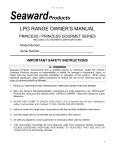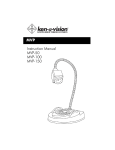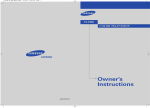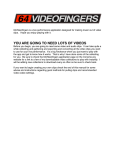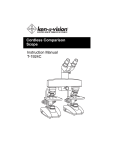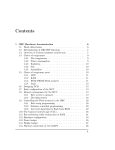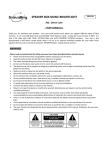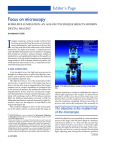Download User Manual - Ken-A
Transcript
Research Scope Instruction Manual T-29031 Binocular Acromat Research Scope T-29041 Trinocular Acromat Research Scope T-29032 Binocular Semi-Plan Research Scope T-29042 Trinocular Semi-Plan Research Scope T-29033 Binocular Acromat Plan Research Scope T-29043 Trinocular Acromat Plan Research Scope T-29034 Binocular Infinity Achromat Research Scope T-29044 Trinocular Infinity Achromat Research Scope T-29035 Binocular Infinity Semi-Plan Research Scope T-29045 Trinocular Infinity Semi-Plan Research Scope T-29036 Binocular Infinity Plan Research Scope T-29046 Trinocular Infinity Plan Research Scope 2 Thank you for purchasing a Ken-A-Vision Research Microscope. The modern Ken-A-Vision research microscope is a professional laboratory instrument designed for modern biology and medical science classrooms, clinical experiments in biology, pharmacology, bacteriology, microbiology and genetics. Its modular design allows for a full range of accessories. It has a modern, ergonomic design with many advanced features so users can operate the instrument conveniently and safely. T-29031 T-29041 T-29032 T-29042 T-29033 T-29043 Halogen Light 12V 20 W D D D D D D High Bright Köhler Illumination D D D D D D Low Coaxial Fine Focus Scale 0.002mm D D D D D D 30° Inclined Binocular 55mm - 75mm D 30° Inclined Trinocular 55mm-75mm Eyepieces - 10X D D D D D D D D D D D Achromat Achomat Semi-Plan Achomat Semi-Plan Achomat Plan Achomat Plan Achromat Double layered mechanical stage 180mm x 150 mm D D D D D D Gimbaled N.A. 1.25 Abbé Condenser with built-in Iris Diaphragm and filters for Köhler Illumination D D D D D D DIN 4X, 10X, 40X, 100X Oil Objectives 3 T-29034 T-29044 T-29035 T-29045 T-29036 T-29046 Halogen Light 12V 20 W D D D D D D High Bright Köhler Illumination D D D D D D Low Coaxial Fine Focus Scale 0.002mm D D D D D D 30° Inclined Binocular 55mm - 75mm D 30° Inclined Trinocular 55mm-75mm Eyepieces - 10X D D D D D D D D D D D Achomat Infinity Achomat Infinity Semi-Plan Infinity Semi-Plan Infinity Plan Infinity Plan Infinity Double layered mechanical stage 180mm x 150 mm D D D D D D Gimbaled N.A. 1.25 Abbé Condenser with built-in Iris Diaphragm and filters for Köhler Illumination D D D D D D DIN 4X, 10X, 40X, 100X Oil Objectives 4 OPERATION Illumination: On any light microscope, the ability to adjust light is probably the most import element after the quality of the lens systems. The Ken-A-Vision Research Microscope has 4 distinct mechanisms to adjust light intensity, and thereby allowing for High Bright Köhler Illumination. The degree of light intensity needed depends on individual conditions such as specimen density, contrast, translucence and staining, objective magnification and individual users eyesight Avoid turning the light onto full brightness as this shortens the life of the bulb. Too little or two much light is rarely recommended. Light entering into the objective from the sub-stage illuminator may be modified by: • A Dimmer (Rheostat) switch on the bottom left side • A Disc Iris diaphragm (Field Diaphragm) on the top of the illuminator in the base • A Disc Iris diaphragm (Condenser Diaphragm) mounted within the Abbé Condenser • Raising and lowering the condenser The amount of light may also be manipulated by moving the gimbaled condenser by using the three substage manipulating screws. High Bright Köhler Illumination: Köhler Illumination - Defined Köhler illumination is a method to reduce an old problem of transmitted light microscopes. The filament of illuminating bulb of the microscope is often visible in the same plane as the sample, reducing resolution and sharp focus. One simple, partial solution is to reduce the amount of light striking the specimen, however reducing voltage to reduce light intensity may also reduce the breath of wavelengths (hues) reaching the specimen. Various other modifications have been done over time including opal bulbs, or placing a glass diffuser lens in front of the bulb. Though all these techniques work to some degree, they tend to reduce the quality (some wavelengths of light are lost) or the amount of incident light. Köhler illumination can be created on microscopes with quality diaphragms, a moveable (both horizontally and vertically) condenser, and a variable light source. Uniformity of light is essential to avoid shadows, glare, and inadequate contrast when taking photomicrographs. Köhler illumination overcomes these limitations. 5 How to set up your Ken-A-Vision Research Microscope for High Bright Köhler Illumination • • • • • • • • Focus on the specimen with whatever objective desired for use. Close the field diaphragm (located on top of the illuminator in the base) to its most closed position - you may see the edges of the diaphragm within the microscope field (they may be blurry). Using the black condenser knob at the sub-stage back left of the microscope, bring the edges of the field diaphragm into the best focus possible. Now using the condenser centering screws of the gimbaled mount, center the image of the closed field diaphragm in the field of view. IMPORTANT NOTE - There are three screws in the gimbals, the rear-most one on the right side is a locking screw, not a positioning screw. Before making ANY adjustments, loosen this screw and then center the image as described above using the other two screws, one on the right and one on the left. Lock the gimbals into position with the third screw. Open the field diaphragm just enough so that its edges are just beyond (outside) the field of view. Now work with the condenser diaphragm by adjusting it to introduce the desired amount of contrast into the sample. Be careful, too much contrast can introduce artifacts into your view, and misrepresent what you actually see in the specimen. Finally adjust the light intensity to your comfort level. If available, it is better to use a neutral density filter in the filter holder (below the bottom of the condenser) then severely reducing the light intensity. A neutral density filter tends to block all wave lengths equally. Reduction of voltage to the light source, particularly with Tungsten lights, tends to alter the actual wave spectrum being emitted by the light source and thereby the hues of light actually being transmitted through the specimen to the objectives. Focus: Place a specimen slide on the center of stage. Before looking into the eyepieces and using either the 4X or 10X objectives with the 10X eyepiece, raise the stage as high as possible. While looking through the eyepieces, slowly rotate the coarse focus knob (stage will lower). When image begins to appear, switch to using the fine focus knob to obtain a sharp image. To switch to higher powers, rotate the objectives clockwise (from right to left). When changing to other objectives, the T-290XX objective lens is parfocal, and only a slight adjustment (if any) of the fine adjust, will bring the image quickly into clear focus. As you go up in power, the objectives are getting closer to the cover slip of the specimen (the working distance is getting smaller). The 40X and above 6 objectives are all spring-loaded so they should slide onto the cover slip WITHOUT any force. If you have to force the objecting into position, STOP, your specimen and/or cover slip may be too thick, and you risk scratching the objective and/or smashing the slide. The tightness of the coarse focus knob has been adjusted at the factory. If it is too loose (the stage falls automatically), please adjust the tension using the coarse adjustment tension ring (located on the right side of the microscope, between the coarse adjust knob and the body of the microscope. To tighten the tension, turn the knob clockwise (towards the back), to loosen the tension turn the knob counterclockwise (towards the front of the microscope) until a suitable position is found. The stage should not move on its own as it sits waiting for your next use. Bulb replacement - (Replacement bulb is Ken-A-Vision Part # T6V20WP) IMPORTANT NOTE: Before replacing the lamp, turn OFF the power switch and unplug from electrical source. Place microscope on its side or back, exposing the bottom of the unit. Unscrew the knurled knob that is towards the front of the unit to open the access door. (Be careful, if unit has been recently used, knurled knob could be very hot). Pull lamp door down and remove lamp by pulling straight out of socket. When replacing the lamp, do not touch the glass of the bulb with bare hands, as the oil from your fingers can damage the bulb and definitely will shorten the life of the bulb. Wear gloves or keep the protective cover on the bulb during installation. Should you accidentally put any fingerprints on the bulb, wipe then off carefully using a clean cloth. 7 Useful microscopy definitions and Research Scope options Objective Lenses There are typically three types of objective lenses found on brightfield microscopes - Achromat, semi-plan, and plan objectives. To understand the difference, realize that all microscope lenses are curved, which results in an image that is slightly out of focus at the edges, and may produce chromatic or spherical aberrations due to this curved shape. Achromat Objective - An achromatic lens (achromat) is an objective lens that is designed to limit the effects of chromatic and spherical aberration (See notes below). Achromatic lenses are corrected by bringing two wavelengths (typically red and blue) into focus in the same plane. An objective that is Achromatic carries the implication (guarantee) that at least 60% of the field of view will have a quality flat focus. Semi-Plan Objective - Semi-Plan objectives are guaranteed to have a quality flat field of focus for 80% of the field of view. A Semi-Plan Achromat lens is also corrected for chromatic aberrations, as described above. Plan Objective - Plan Objectives guarantee a quality flat field of focus for 100% of the field of view. A Plan Achromat lens will also have the same corrections for chromatic aberrations as noted above. In Plan Objectives when imaging the field, parts of the specimen at the edge of the visual field are almost as well focused as those in the center. Straight lines on the specimen appear straight throughout the visual field, without any aberrations. Such microscopes are especially good for photomicrography. In general, the better the plan field objective, the more expensive the lens. Flat Field Objectives - As one looks at the field of view, there may be slight blurring at the edge of the field. This edge blurring of Flat Field objectives is slight and easily corrected by a small tweak of the fine focus knob as one looks toward the edge of the field, or by moving the specimen so that the portion that is at the edge is moved into the center of the viewing field. Flat Field Objectives tend to be inexpensive when compared to Plan Field. Plan Field versus Flat Field Objectives - Most educational, teaching microscopes are Flat Field Objectives due to this cost difference. Infinity - Infinity lenses - In microscopy, the term "infinity" means that the objective lenses are designed to project their images to infinity, not to some finite distance. Traditional brightlight microscopes had a "fixed" focal point at 8 160 mm established by standard in the 1800's. The infinity optical system provides an "infinite" region of parallel light between objective and eyepiece, pushing the image out approaching infinity Aberrations - Chromatic, Achromatic or Spherical - Any change from idealized and/or uniform light conditions coming through a lens is called an aberration. Chromatic aberration - White light is made up with all the colors or wavelengths of the visible spectrum. These color components travel through the lens at different wave lengths and in doing so the lenses of the microscope may cause the different colors to refract (bend from a straight line) at different angles; This is called chromatic aberration. Achromatic aberrations - Achromatic aberrations are caused by distortions in the smoothness of the lenses. The image appears blurry in places. Spherical aberrations - Spherical aberration occurs when the rays of light passing through the center of the lens tend to focus on a different plane than those entering near the edge of the lens. This is because the curvature of the lens is not perfect. The variance in cost of microscopes, in general, is often attributed to the cost of lenses needed to cure this problem. Often the only way that these problems can be overcome is by using a series of lenses, each lens carefully being designed to counteract the aberrations of the other lenses. Phase Contrast microscopy - Phase contrast microscopy is an illumination technique useful when looking at transparent specimens, which because they lack color are difficult to visualize. This modification of the microscope causes small phase shifts in the light passing through a transparent specimen and these shifts are converted into amplitude or contrast changes in the wave lengths of the light being transmitted through the image and up to the observer's eye. 9 CARE AND MAINTENANCE Cleaning The T-290XX Research Microscopes are precision instruments. Routine or protective care and maintenance is highly recommended. • Always wipe off any (immersion) oil from objectives, stage and condenser immediately. More persistent dirt, such as fingerprints, grease and/or oil, may be removed with soft cotton or lens tissue, lightly moistened with lens cleaner. • Frequently wipe off eyepieces, objective lenses and condenser lens with high quality lens paper. Particularly remove any oils accumulated from finger prints and hands resting on microscope parts. • Dry objective lenses, condenser lens, and stage immediately after any water spillage. • Never leave the microscope with any of the objectives or eyepieces removed as dust and debris will collect in tubes and on ends of eyepieces. • Always protect the microscope with the dust cover when not in use. • Store microscope in a dry environment, particularly avoid storing unit where it may be exposed to any chemical volatiles or other airborne corrosives. Long Term Maintenance All optical and mechanical equipment requires periodic servicing to keep it performing properly. Ken-A-Vision recommends the user anticipate this need by establishing a schedule of regular preventive maintenance to help to assure long life and sustain optimum performance of your instrument. Such a program of planned preventive maintenance should be done by qualified trained personnel. This maintenance should include: • A thorough cleaning of eyepieces and objective lenses • Cleaning and checking for corrosion of retractable lenses • Adjustment of all mechanical parts including the coarse and fine adjust, tension adjustment, mechanical stage, 360° head rotation • Electrical system -power cord (damage, fraying, other wear), check for evidence of any wire or socket damage within the light bulb compartment • Check for any rust or corrosion, other physical damage to the unit. Ken-A-Vision has quality technicians on staff to repair and service your microscopes. Contact Ken-A-Vision at 1.816.353.4787 for more details. 10 Accessories If you are interested in purchasing accessories or replacement parts for your Research Scope, visit the Ken-A-Vision Web site, http://store.kenavision.com/ catalog/ or contact your local Ken-A-Vision Dealer. 11 Ken-A-Vision reserves the right to make design improvements and other changes in accordance with the latest technology. There is no obligation to make changes in products already manufactured. Patents Pending Copyright 2009 Ken-A-Vision Corporation. 5615 Raytown Road • Kansas City, MO 64133 U.S.A. Tel.: 816-353-4787 • Fax: 816-358-5072 email:[email protected] • www.ken-a-vision.com INS-SC29














